- Home
- Maurice Druon
The Lily and the Lion
The Lily and the Lion Read online
Copyright
HarperVoyager
An imprint of HarperCollinsPublishers Ltd
77–85 Fulham Palace Road
Hammersmith, London W6 8JB
www.harpercollins.co.uk
First published in Great Britain by Rupert Hart-Davis 1961
Arrow edition 1988
Copyright © Maurice Druon 1960
This translation © Rupert Hart-Davies Ltd 1961
Cover Illustration © Patrick Knowles
Cover layout design © HarperCollinsPublishers Ltd 2014.
Maurice Druon asserts the moral right to be identified as the author of this work.
A catalogue copy of this book is available from the British Library.
This novel is entirely a work of fiction. The names, characters and incidents portrayed in it are the work of the author’s imagination. Any resemblance to actual persons, living or dead, events or localities is entirely coincidental.
All rights reserved under International and Pan-American Copyright Conventions. By payment of the required fees, you have been granted the non-exclusive, non-transferable right to access and read the text of this e-book on screen. No part of this text may be reproduced, transmitted, down-loaded, decompiled, reverse engineered, or stored in or introduced into any information storage and retrieval system, in any form or by any means, whether electronic or mechanical, now known or hereinafter invented, without the express written permission of HarperCollins.
Source ISBN: 9780007491353
Ebook Edition © September 2014 ISBN: 9780007492268
Version: 2014-08-26
‘History is a novel that has been lived’
E. & J. DE GONCOURT
‘It is terrifying to think how much research is needed to determine the truth of even the most unimportant fact.’
STENDHAL
Contents
Cover
Title Page
Copyright
Epigraph
Foreword
The Characters in this Book
Family Tree
The Lily and The Lion
Part I: The New Kings
1. The January Wedding
2. Travail for a Crown
3. A Corpse in Council
4. The Makeshift King
5. The Giant and the Mirrors
6. Homage and Perjury
Part II: The Devil’s Game
1. The Witnesses
2. The Plaintiff Conducts the Inquiry
3. The Forgers
4. The Guests at Reuilly
5. Mahaut and Beatrice
6. Beatrice and Robert
7. Bonnefille House
8. Return to Maubuisson
9. The Wages of Sin
Part III: Decline and Fall
1. The Phantom Bait
2. The Axe in Nottingham
3. To the Common Gallows
4. A Bad Day
5. Conches
6. The Wicked Queen
7. The Tournament at Evreux
8. The Honour of a Peer and the Honour of a King
9. The Tolomei
10. The Seat of Justice
Part IV: The War-Brand
1. The Outlaw
2. Westminster Hall
3. The Defiance at the Tower of Nesle
4. Windsor
5. The Heron and the Oath
6. The Walls of Vannes
Epilogue: 1354–62
1. The Road to Rome
2. The Night at the Capitol
3. ‘We, Cola di Rienzi …’
4. Jean I, The Unknown
Footnotes
Historical Notes
Bibliography
Author’s Acknowledgements
By Maurice Druon
About the Publisher
Foreword
GEORGE R.R. MARTIN
Over the years, more than one reviewer has described my fantasy series, A Song of Ice and Fire, as historical fiction about history that never happened, flavoured with a dash of sorcery and spiced with dragons. I take that as a compliment. I have always regarded historical fiction and fantasy as sisters under the skin, two genres separated at birth. My own series draws on both traditions … and while I undoubtedly drew much of my inspiration from Tolkien, Vance, Howard, and the other fantasists who came before me, A Game of Thrones and its sequels were also influenced by the works of great historical novelists like Thomas B. Costain, Mika Waltari, Howard Pyle … and Maurice Druon, the amazing French writer who gave us the The Accursed Kings, seven splendid novels that chronicle the downfall of the Capetian kings and the beginnings of the Hundred Years War.
Druon’s novels have not been easy to find, especially in English translation (and the seventh and final volume was never translated into English at all). The series has twice been made into a television series in France, and both versions are available on DVD … but only in French, undubbed, and without English subtitles. Very frustrating for English-speaking Druon fans like me.
The Accursed Kings has it all. Iron kings and strangled queens, battles and betrayals, lies and lust, deception, family rivalries, the curse of the Templars, babies switched at birth, she-wolves, sin, and swords, the doom of a great dynasty … and all of it (well, most of it) straight from the pages of history. And believe me, the Starks and the Lannisters have nothing on the Capets and Plantagenets.
Whether you’re a history buff or a fantasy fan, Druon’s epic will keep you turning pages. This was the original game of thrones. If you like A Song of Ice and Fire, you will love The Accursed Kings.
George R.R. Martin
The Characters in this Book
THE HOUSE OF FRANCE:
The King: PHILIPPE VI OF VALOIS, great-grandson of Saint Louis, nephew of Philip the Fair, eldest son of Count Charles of Valois and his first wife, Marguerite of Anjou-Sicily, aged 35.fn1
The Queen: JEANNE OF BURGUNDY, called the Lame, grand-daughter of Saint Louis, sister of Duke Eudes IV and of the late Queen Marguerite of Burgundy, aged 33.
Their Eldest Son: JEAN, Duke of Normandy, the future King JEAN II, the Good, aged 9.
The Dowager Queens: JEANNE OF EVREUX, daughter of Louis of France, Count of Evreux, and niece of Philip the Fair, third wife and widow of King Charles IV, the Fair, aged about 25.
JEANNE OF BURGUNDY, called the Widow, daughter of Mahaut of Artois and wife of the late King Philippe V, the Long, aged 35.
THE HOUSE OF ENGLAND:
The King: EDWARD III PLANTAGENET, son of Edward II and Isabella of France, aged 16.
The Queen: PHILIPPA OF HAINAUT, second daughter of Count Guillaume of Hainaut and Jeanne of Valois, aged 14.
The Queen Mother: ISABELLA OF FRANCE, widow of Edward II, daughter of Philip the Fair, aged 36.
The King’s Relatives: HENRY, called Wryneck,fn2 Earl of Leicester and Lancaster, aged 47.
EDMUND, Earl of Kent, uncle of King Edward III, aged 27.
THE HOUSE OF NAVARRE:
The Queen: JEANNE OF NAVARRE, daughter of Louis the Hutin and Marguerite of Burgundy, granddaughter of Philip the Fair, heiress to the Kingdom of Navarre, aged 17.
The King: PHILIPPE OF FRANCE, Count of Evreux, son of Louis of France and husband of the above, aged about 21.
THE HOUSE OF HAINAUT:
GUILLAUME, called the Good, Sovereign Count of HAINAUT, Holland and Zeeland, father of Queen Philippa of England.
JEANNE OF VALOIS, Countess of Hainaut, wife of the above and sister of King Philippe VI of France.
JEAN OF HAINAUT, younger brother of Count Guillaume.
THE HOUSE OF BURGUNDY:
EUDES IV, Duke of BURGUNDY, brother of the late Queen Marguerite of Burgundy and of Queen Jeanne the Lame, a Peer of France, ag
ed about 46.
JEANNE OF BURGUNDY, his wife, daughter of King Philippe V, the Long, granddaughter of Mahaut of Artois, aged 19.
THE HOUSE OF ARTOIS:
MAHAUT, Countess of ARTOIS, widow of Count Othon IV of Burgundy, mother of the Queen Dowager Jeanne the Widow and grandmother of Duchess Jeanne of Burgundy, a Peer of France, aged 59.
ROBERT OF ARTOIS, Count of Beaumont-le-Roger, Lord of Conches, a nephew of the above, cousin and brother-in-law of King Philippe VI, a Peer of France, aged 41.
JEANNE OF VALOIS-COURTENAY, half-sister of King Philippe VI, wife of Robert of Artois, but always known as the Countess of BEAUMONT, aged 24.
PEERS, PRELATES AND DIGNITARIES OF THE HOUSE OF FRANCE:
LOUIS I, Duke of BOURBON, Great Chamberlain of France, grandson of Saint Louis, son of Robert of Clermont, a Peer of France.
LOUIS OF NEVERS, Count of Flanders, a Peer of France.
GUILLAUME DE TRYE, Duke-Archbishop of Reims, a Spiritual Peer.
JEAN DE MARIGNY, Count-Bishop of Beauvais, younger brother of Enguerrand de Marigny, a Spiritual Peer.
GAUCHER DE CHTILLON, Count of Porcien and Lord of Crèvecoeur, Constable of France 1302–1329.
RAOUL DE BRIENNE, Count of Eu, Constable on the decease of the above.
HUGUES, Count de BOUVILLE, ex-Chamberlain to Philip the Fair.
JEAN DE CHERCHEMONT, Chancellor in 1328.
GUILLAUME DE SAINT-MAURE, Chancellor from 1329.
MILLE DE NOYERS, ex-Marshal of France, President of the Exchequer, President of Parliament.
ROBERT BERTRAND, called the Knight of the Green Lion, and MATHIEU DE TRYE, Marshals of France.
BÉHUCHET, an Admiral.
JEAN THE FOOL, a dwarf.
LORDS, PRELATES AND DIGNITARIES OF THE HOUSE OF ENGLAND:
ROGER MORTIMER, eighth Baron Wigmore, first Earl of March, ex-Justiciar of Ireland, the lover of Isabella, the Queen Mother, aged 42.
WILLIAM DE MELTON, Archbishop of York, Primate of England.
HENRY DE BURGHERSH, Bishop of Lincoln, Chancellor and Ambassador.
ADAM ORLETON, formerly Bishop of Hereford, now of Worcester, and later of Winchester, Treasurer and Ambassador.
JOHN, Baron MALTRAVERS, Seneschal of England, aged about 38.
WILLIAM, Baron MONTACUTE, first Earl of SALISBURY, Councillor and Ambassador, later Lord Warden of the Cinque Ports and Marshal of England, aged 27.
GAUTIER DE MAUNY, Equerry to Queen Philippa.
JOHN DAVERILL, Governor of Corfe Castle.
WILLIAM ELAND, Governor of Nottingham Castle.
THE PRINCIPAL LAWYERS AND ACTORS IN THE ARTOIS CASE:
PIERRE DE VILLEBRESME, the Commissioner.
PIERRE TESSON, a notary.
JEANNE DE DIVION, ex-mistress of the late Bishop Thierry d’Hirson.
BEATRICE D’HIRSON, niece of Bishop Thierry, Lady-in-Waiting to the Countess Mahaut of Artois.
GILLET DE NELLE, Valet to Robert of Artois.
MARIE LA BLANCHE, MARIE LA NOIRE and JEANNETTE DESQUESNES, servants of Jeanne de Divion.
PIERRE DE MACHAUT, a witness.
ROBERT ROSSIGNOL, a forger.
MACIOT L’ALLEMANT, a Sergeant-at-Arms.
SIMON DE BUCY, the King’s Attorney.
THE EMPEROR OF GERMANY:
LOUIS V OF BAVARIA.
THE KING OF BOHEMIA:
JOHN OF LUXEMBURG, son of the Emperor Henry VII of Germany.
THE KING OF NAPLES:
ROBERT OF ANJOU-SICILY, called the Astrologer, uncle of King Philippe VI of France.
THE KING OF ARAGON:
ALFONSO IV.
THE KING OF HUNGARY:
LOUIS I, the Great.
THE POPES:
JOHN XXII, formerly Cardinal Jacques DUÈZE, BENEDICT XII (from 1334), formerly Jacques FOURNIER, called the White Cardinal.
JAKOB VAN ARTEVELDE, leader of the Flemish League.
COLA DI RIENZI, Tribune of Rome.
SPINELLO TOLOMEI, a Sienese banker.
JEAN I, THE POSTHUMOUS, called GIANNINO, son of Louis X, the Hutin, and Clémence of Hungary, pretender to the throne of France.
The Lily and The Lion
Mahaut, Countess of Artois, was in a very bad temper all the way home.
‘Did you hear what that great fool we’re unlucky enough to have for King said? He expects me to give up Artois, just like that, and merely to please him! The very idea of making that great foul Robert my heir! My hand would wither away before it signed a thing like that! They’ve clearly been accomplices in roguery for a long time past and owe each other a lot! And to think that if it weren’t for my having cleared the path to the throne …’
‘Mother …’ Jeanne murmured in a low voice.
If she had dared to say what she thought and had not been afraid of a savage rebuff, Jeanne would have advised her mother to accept the King’s proposals. But it would have done no good.
‘He’ll never get me to agree to that,’ repeated Mahaut.
Though she did not know it, she had signed her death-warrant; and her executioner was sitting opposite her in the litter, looking at her through her dark lashes.
PART ONE
THE NEW KINGS
1.
The January Wedding
FROM BOTH SIDES of the river and from every parish in the city, from St Denis, St Cuthbert, St Martin-cum-Gregory, St Mary Senior and St Mary Junior, from the Shambles and from Tanner Row, the people of York had been flowing for the past two hours in a continuous stream towards the huge but still-unfinished Minster that brooded heavily over the city.
The crowd completely blocked the two winding streets of Stonegate and Deangate which led into the yard. Boys, who had found perches above the crowd, could see nothing but a sea of heads covering the whole area. Burgesses, tradesmen, matrons with their numerous broods, cripples on crutches, servants, apprentices, hooded monks, soldiers in shirts of mail and beggars in rags were all crowded as close together as the stalks in a truss of hay. The light-fingered pickpockets were reaping a year’s harvest. Faces filled the upper windows like so many bunches of grapes. The damp, cold, misty twilight that enveloped the great building and the crowd standing in the mud seemed scarcely that of noon. It was as if the gathering was pressing close together for warmth.
It was January 24th, 1328, and, in the presence of William de Melton, Archbishop of York and Primate of England, King Edward III, who was not yet sixteen, was marrying his cousin, Madam Philippa of Hainaut, who was barely more than fourteen.
There was not an empty seat in the cathedral. They had all been reserved for the high dignitaries of the kingdom, members of the upper clergy and Parliament, the five hundred invited knights and the hundred tartan-clad Scottish nobles, who had come south to ratify the Peace Treaty. Soon the solemn mass would be celebrated, sung by a hundred and twenty choristers.
Now, however, the first part of the ceremony, the marriage proper, was taking place outside the south door of the cathedral in view of the people, according to the ancient rite and peculiar custom of the archdiocese of York, as a reminder that marriage was a sacrament between husband and wife, affirmed by mutual vows taken in public, to which the priest was merely a witness.
The mist had stained the red velvet of the canopy over the door with patches of damp, it had condensed on the bishops’ mitres, and had bedraggled the fur about the shoulders of the royal family assembled round the young couple.
‘Here I take thee, Philippa, to my wedded wife, to have and to hold, at bed and at board …’1 fn1
Coming from the King’s young lips and beardless face, his voice was surprisingly powerful, clear and vibrantly intense. Isabella, the Queen Mother, was struck by it, and so were Messire Jean of Hainaut, the bride’s uncle, and the others standing near, such as Edmund, Earl of Kent, and Wryneck, Earl of Lancaster, Chief of the Council of Regency and the King’s tutor.
The barons had heard their new King speak with such unexpected force only once before – on
a day of battle in the last Scottish campaign.
‘… for fairer for fouler, for better for worse, in sickness and in health …’
The whispering of the crowd gradually subsided; silence spread like a circular ripple and the royal young voice rang out above those thousands of heads, audible almost to the far end of the yard. The King slowly recited the long vow he had learned the previous day; but he might have been inventing it afresh, so clearly did he articulate each phrase and lend each word grave and profound significance. It was like a prayer said once, and destined to last a lifetime.
The boyish figure seemed endued with the mind of a man supremely sure of the vow he was taking in the face of Heaven, of a prince conscious of the part he had to play between his people and his God. The new King was taking his family, his friends, his great officers of State, his barons, his prelates, his people of York and, indeed, of all England, to witness the love he was vowing to Madam Philippa.
Prophets burning with the zeal of God and leaders of nations who are imbued with some unique conviction can infect the crowd with their faith. A public affirmation of love also has this power, and can make everyone share one man’s emotion.
There was not a woman in the crowd, whatever her age, whether she was newly married, was deceived by her husband, was a widow, a virgin or a grandmother, who did not feel herself at that moment to be standing in the bride’s place; and there was not a man who did not identify himself with the young King. Edward III was uniting himself to every woman among his people; and it was his whole kingdom that was taking Philippa to wife. The dreams of youth, the disillusionments of maturity, and the regrets of old age were all centred on the young couple – heartfelt offerings. And, when darkness fell in the ill-lit streets, the eyes of betrothed couples would glow brighter in the night, and husbands and wives, who had been long at enmity, would reach for each other’s hands when supper was done.
From the beginning of time people have crowded to the weddings of princes, in order to enjoy a vicarious happiness which, when seen in the highest, must seem perfect.
‘… till death us do part …’
There was a lump in every throat; a vast, sad, almost reproachful sigh rose from the crowd. At such a moment, there should be no mention of death. Surely this young couple could not be mortal or subject to the common lot?

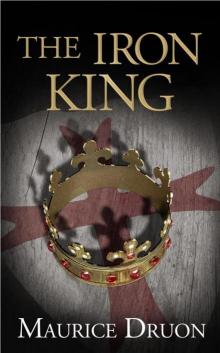 The Iron King
The Iron King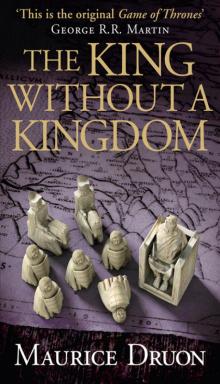 The King Without a Kingdom
The King Without a Kingdom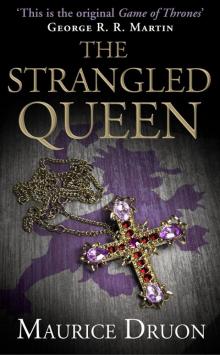 The Accursed Kings Series Books 1-3: The Iron King, the Strangled Queen, the Poisoned Crown
The Accursed Kings Series Books 1-3: The Iron King, the Strangled Queen, the Poisoned Crown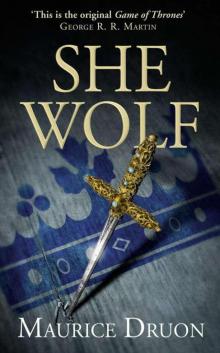 The She-Wolf
The She-Wolf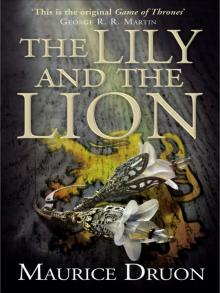 The Lily and the Lion
The Lily and the Lion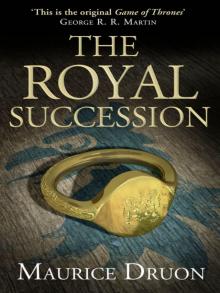 The Royal Succession
The Royal Succession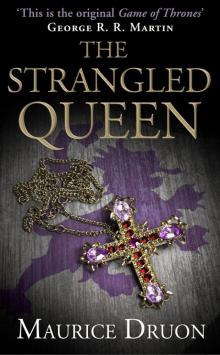 The Strangled Queen
The Strangled Queen The Poisoned Crown
The Poisoned Crown